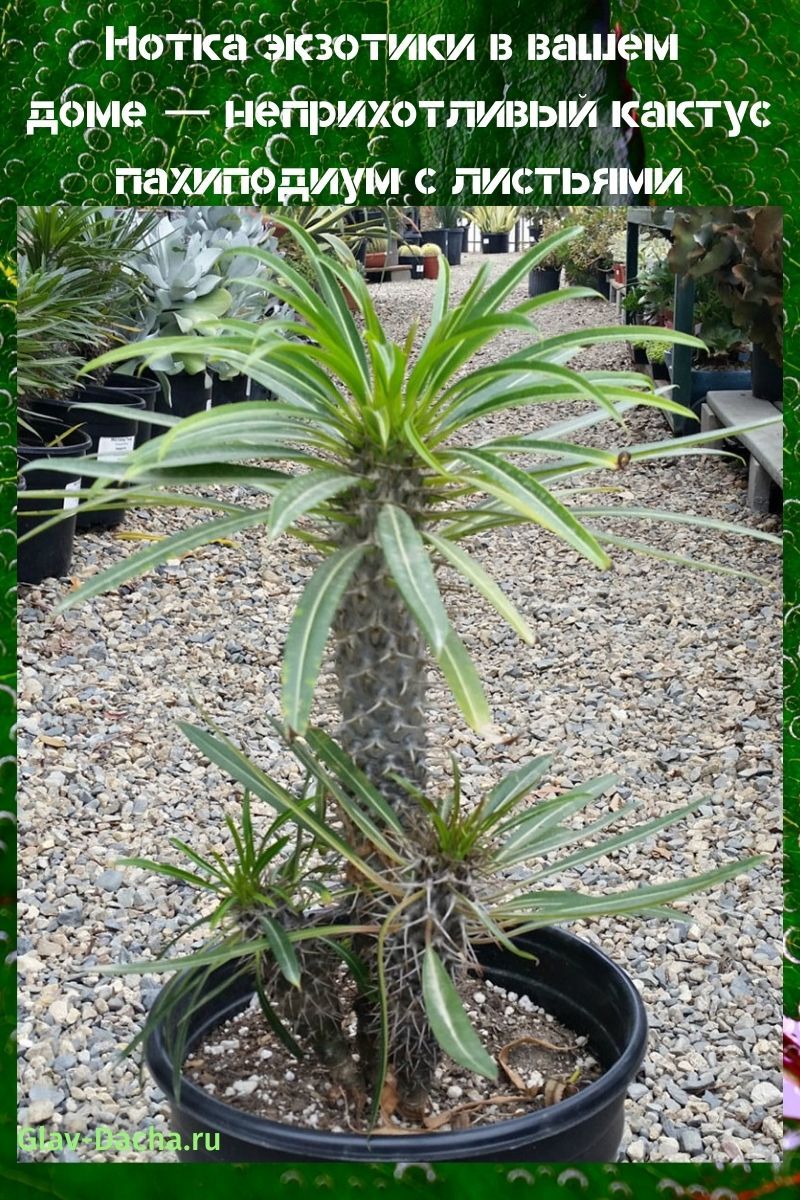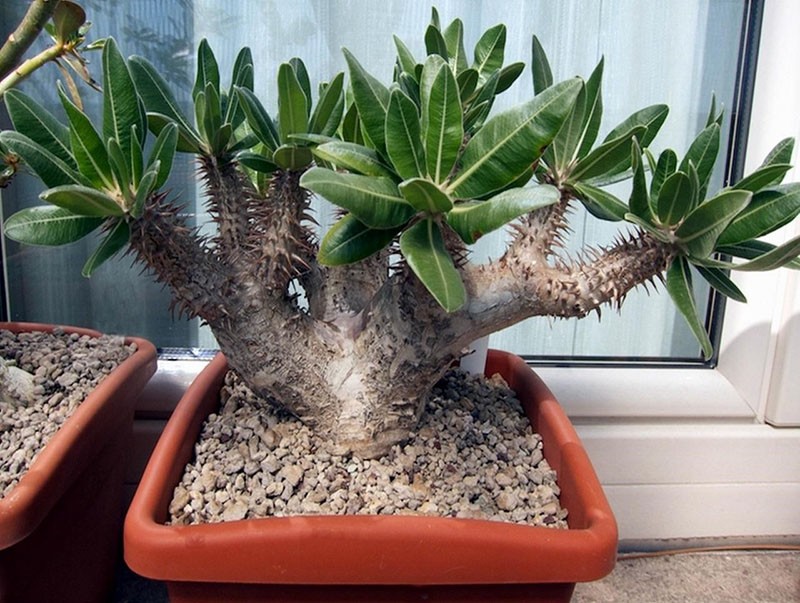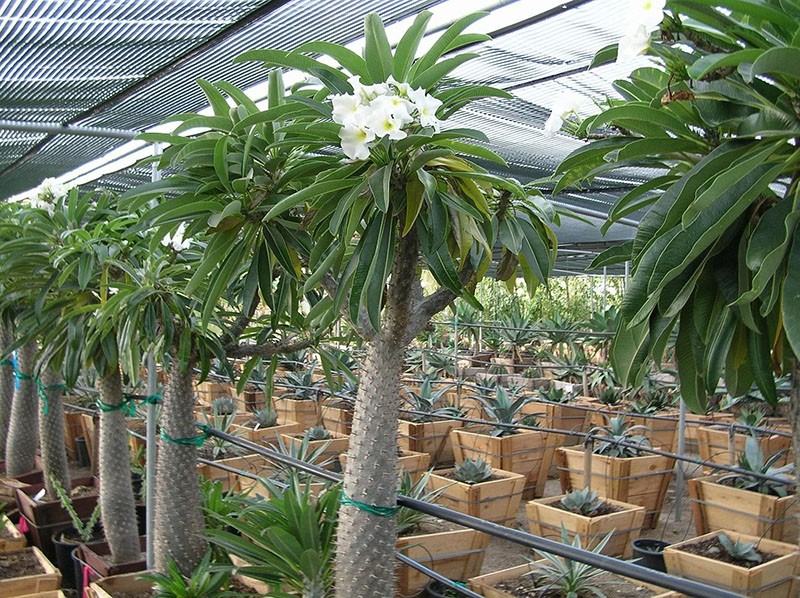A touch of exotic in your home - unpretentious pachypodium cactus with leaves
 An unusual prototype of a palm tree with a thick trunk and massive thorns will perfectly fit into the interior of any home. Since the pachypodium cactus with leaves grows on various types of soils and is unpretentious to growing conditions, it is worth paying special attention to this succulent.
An unusual prototype of a palm tree with a thick trunk and massive thorns will perfectly fit into the interior of any home. Since the pachypodium cactus with leaves grows on various types of soils and is unpretentious to growing conditions, it is worth paying special attention to this succulent.
"Uncommon appearance"


Other features of the succulent include:
- Thorns. They cover the entire surface of the trunk (in a circle or spiral), which has a silvery or olive tint. These thorns act not only as a repellent against insects, but also serve as tubes through which the plant absorbs moisture from the environment (from fog or dew).

- Leaves. Usually the plates are narrow and long. They are collected in a panicle located exclusively in the upper part. Due to the small evaporation area, the flower can accumulate much more moisture.

- Bloom. Depending on the variety (there are about 30 of them), the flowers are bright yellow, pink or white. On a small peduncle, large, tubular corollas with five petals develop, sometimes with a contrasting vein in the center. However, indoors, the cactus rarely blooms.

At home, the pachypodium (from Lat. "Thick leg") grows up to 1-1.5 m. The flower does not have a dormant period. Its growth per year is 3-5 cm. Life expectancy in an apartment varies from 3 to 15 years.
In the natural environment, both mighty trees up to 6-8 m in height and miniature specimens - no more than 25-30 cm grow. In addition, there are artisanal varieties of this exotic flower with a curved stem. Their spherical crown grows up to 3-4 m in diameter. Most varieties are distinguished by extraordinary branching.
A unique feature of the pachypodium is its lack of milky sap. This biological liquid of the plant has a transparent shade, but it still remains poisonous.
Pachypodium cactus with leaves in its variety
 Despite its South African origin, succulent is adapted to indoor cultivation in northern climates. Many varieties adapt perfectly to these conditions.
Despite its South African origin, succulent is adapted to indoor cultivation in northern climates. Many varieties adapt perfectly to these conditions.
The most popular among them are:
- Lamer. The Madagascar palm tree is characterized by a thickened trunk at the base and large tubercles with thorns (3 pieces in each). Elongated leaves (10-12 cm) are located on large petioles. During the flowering period of the Lamer pachypodium, cream or pink flowers (10 cm in diameter) with a yellowish center bloom at the top of the trunk.

- Lamera is branched. Natural hybrid Ramosum has practically no thorns. But if there are thorns, then they are located on the shoots. Leaves come with a pronounced central vein. Massive umbrella flowers are striking in their snow-white shade.

- Pachypodium Sanders."Star of Lundi" is distinguished by a perfectly flat almost spherical trunk, which is dotted with short shoots. On its textured surface, spikes up to 2.5 cm in length are found separately from each other.

- Zhayi. Under indoor conditions, it reaches 50-70 cm. The trunk at the base has a slight grayish tint, and closer to the crown it acquires a dark resinous color. On the crown, rather narrow leaves 1.5-3 cm wide are collected. A distinctive feature of the variety is the presence of pubescence on deciduous plates.

- Succulent. It is a tree-like species. The trunk grows up to 15 cm in diameter, but its significant part is hidden in the ground. An intensively branching crown rises above it, consisting of many leaves 5-6 cm long. The bush grows up to 60-90 cm. In the axil of each deciduous plate there are 2 short thorns.

The dense-flowered pachypodium with a dark brown trunk is quite branched and looks like a baobab. Each top is dotted with small thorns and dense leaves. Indoors it grows up to 90 cm.
The short-stemmed variety (50-60 cm in height) is especially interesting. Outwardly, it resembles huge tubers or stones standing next to it in the desert.  However, the presence of leaves and thorns turns it into an amazing plant that surprises with its bright lemon-yellow flowers.
However, the presence of leaves and thorns turns it into an amazing plant that surprises with its bright lemon-yellow flowers.
Basic rules of care
 The "harsh" climate of Africa has formed the unpretentious nature of this amazing flower with thorns on the stem. The plant has become thermophilic and drought-resistant. In addition, it is able to successfully adapt to an environment that is unfamiliar to it.
The "harsh" climate of Africa has formed the unpretentious nature of this amazing flower with thorns on the stem. The plant has become thermophilic and drought-resistant. In addition, it is able to successfully adapt to an environment that is unfamiliar to it.
Nevertheless, for the flowerpot, they choose exclusively the southern part of the house or the southwest. It is always taken into account that the pachypodium cactus is "monogamous", that is, it painfully tolerates any further movements.
In addition, they monitor compliance with such indicators:
- Lighting. Bright light with direct sunlight is recommended. When grown in partial shade, it stretches and takes on an ugly appearance.

- Temperature conditions. In summer, marks from 20-30˚C are permissible, and in winter - at least 15˚C. Be sure to protect the flowerpot from sudden changes in temperature and drafts.
- Humidity. Excellent dry air tolerance. Still, for sanitary purposes, it needs spraying or wiping the foliage.
- Watering. The soil is moistened as the earthen coma dries up at a depth of 1 cm. They try not to overmoisten the flower too much in order to avoid decay of the roots. In winter, the number of waterings is halved.
 Features of growing pachypodium also include the method of transplanting the culture. Young specimens are transplanted every year, increasing the diameter of the pot by 2-3 cm, and adults - after 2-3 years. The container is chosen deep enough with several drainage holes that protect against liquid stagnation.
Features of growing pachypodium also include the method of transplanting the culture. Young specimens are transplanted every year, increasing the diameter of the pot by 2-3 cm, and adults - after 2-3 years. The container is chosen deep enough with several drainage holes that protect against liquid stagnation.
At the bottom, a drainage "cushion" is formed (1/3 of the volume), and then the corresponding soil substrate is prepared:
- deciduous land;
- turf;
- perlite or sand.
The last part is taken three times more than the rest. They also practice using a different composition: peat chips, coarse sand and a universal soil mixture intended for indoor plants, or garden soil. In this case, a ratio of 3: 3: 1 is used. In this case, the acidity of the substrate is leveled to 5-7 pH values.
Charcoal or small chips of broken bricks are used as a disinfectant component that prevents the development of rot. In relation to the total mass, 10-15% of such a mixture is added.
Some nuances
 At the same time, the pachypodium cactus with leaves makes special demands on water quality. It should be soft and with a minimum of fluorine and chlorine.
At the same time, the pachypodium cactus with leaves makes special demands on water quality. It should be soft and with a minimum of fluorine and chlorine.
If it is not possible to use melt or rain liquid, then tap water:
- boil;
- defend;
- or soften with vinegar.
A find for a florist will be the Horombenze variety. The plant is quite compact and grows slowly.Arrow-shaped leaves are in good harmony with a wide and branched trunk.
 Succulents rarely need feeding. Cacti react negatively to organic matter and an excess of nitrogenous compounds. If necessary, the flower is watered with a nutrient solution containing useful elements: potassium, phosphorus and nitrogen in a ratio of 3: 2: 1. Adhering to these simple rules of care, the pachypodium cactus will always delight household members with its exotic look.
Succulents rarely need feeding. Cacti react negatively to organic matter and an excess of nitrogenous compounds. If necessary, the flower is watered with a nutrient solution containing useful elements: potassium, phosphorus and nitrogen in a ratio of 3: 2: 1. Adhering to these simple rules of care, the pachypodium cactus will always delight household members with its exotic look.